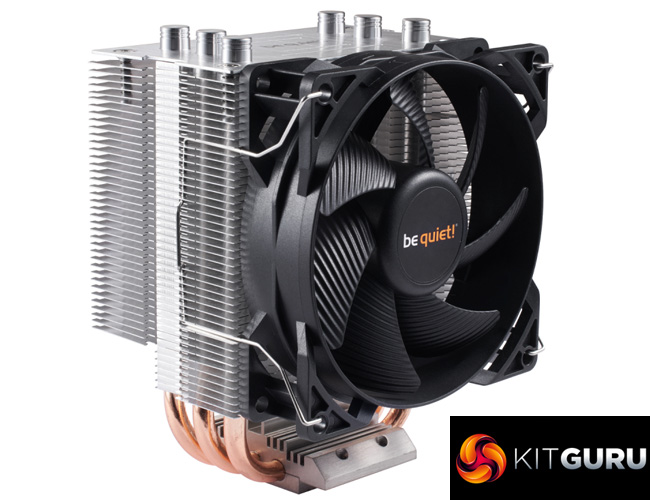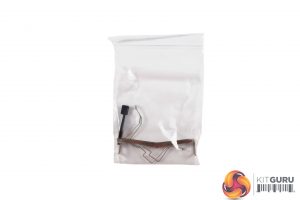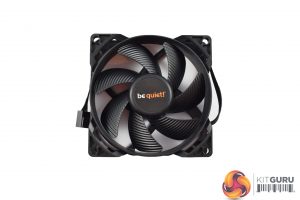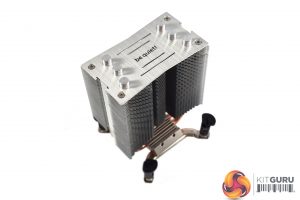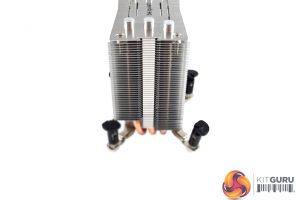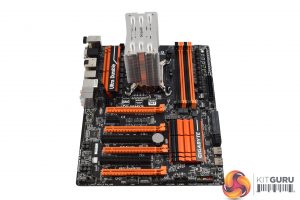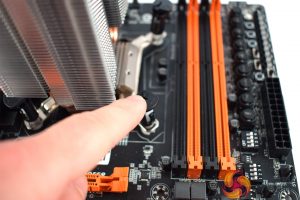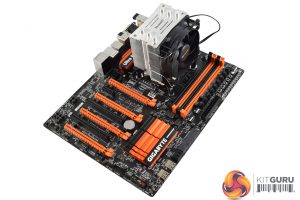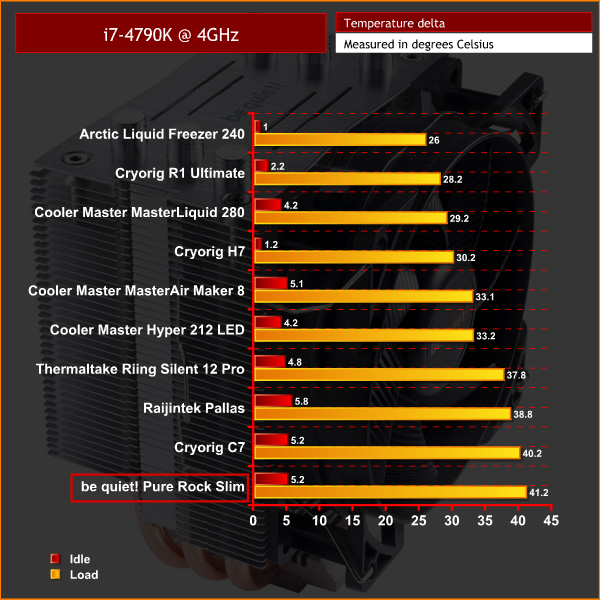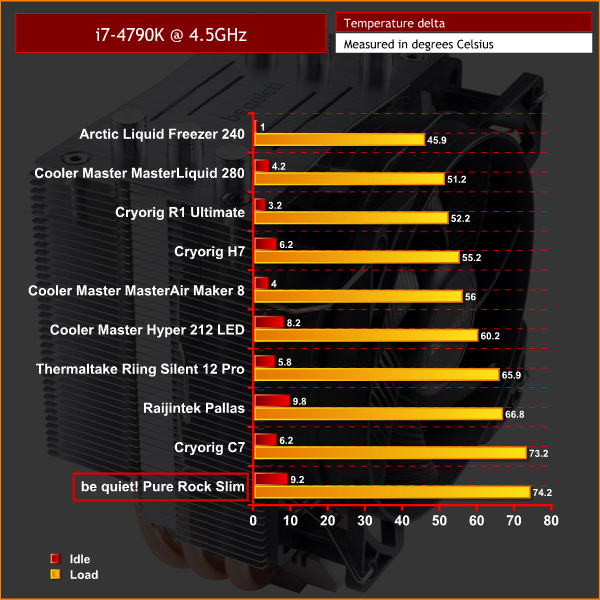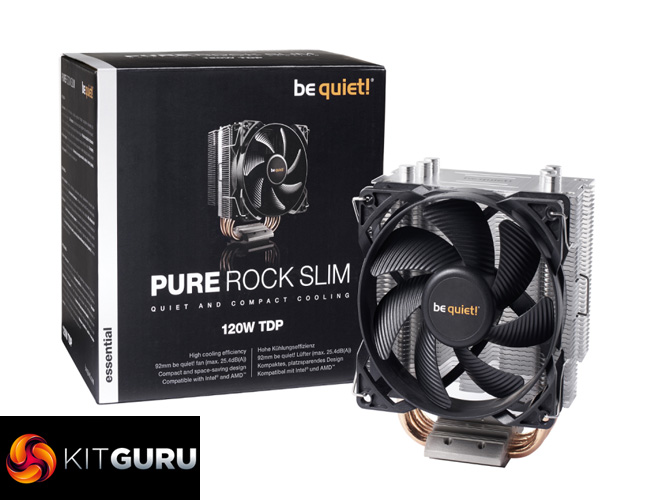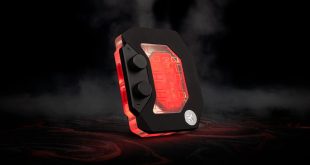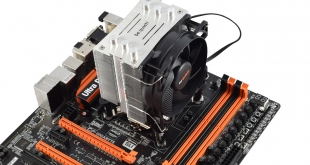
When you think of be quiet! air coolers, you probably think of their massive coolers, such as the Dark Rock or Dark Rock Pro. The Pure Rock Slim is a different beast entirely, though, as it is a minuscule air cooler that boasts just 3 heatpipes and a 92mm fan. Is there a market for something like this?
In the grand scheme of things, this cooler is also quite cheap, coming in at £24.95. Whether or not this means the be quiet! Pure Rock Slim is competitive is another matter, though, so let's dive right into the review and find out.
Main Specification:
- Overall dimensions without mounting material (L x W x H), (mm): 81.8 x 97 x 124.8
- TDP (W): 120
- Backplate Mounting: Yes
- Fan model: 1x silence-optimized be quiet! fan
- Overall noise level (dB(A)) @ 50/75/100% (rpm): 13.1 / 19.2 / 25.4
Heatsink Specification:
- Dimensions (mm): 56.2 x 97 x 124.8
- Number of fins: 33
- Fin material: Aluminium
- Base material: Copper
- CPU contact surface: CNC machined
- Heatpipe number / Diameter (mm): 3, 6
Fan Specification:
- Fan dimensions (mm): 92 x 92 x 25
- Speed @ 100% PWM (rpm): 2,000
- Air flow @ 12V (cfm / m3/h): 35.14 / 59.38
- Air pressure @ 12V (mm H2O): 1.67
- Bearing type: Sleeve
- Motor technology: 4-pole fan motor
- Rated voltage (V): 12
- Input current (A): 0.32
- Input power (W): 3.84
- Connector: 4-pin PWM
- Cable length (mm): 220
- Lifespan (h / 25°C):80,000
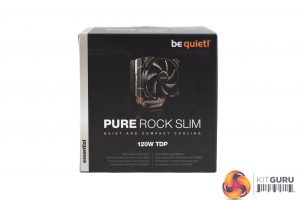
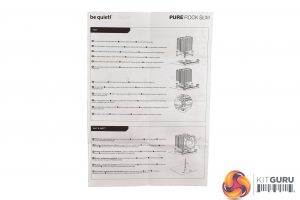
The be quiet! Pure Rock Slim ships in the same style of box that we have seen from every other be quiet! product on the market.
Its manual is quite concise, but as you will see on the next page, the installation process is so simple it does not need to go into much detail.
Other than the heatsink, the box also contains two fan clips and an AMD mounting bracket.
The fan is a 92mm model from be quiet!'s own Silent Wings series, so hopefully it will be nice and quiet.
The heatsink itself is very small for an air cooler, measuring just 56.2mm x 97mm x 124.8mm (L x W x H). This is an interesting size, as it is not small enough to be competing against low-profile coolers, but it is still a fair bit smaller than other air towers like the Cryorig H7 or the Cooler Master Hyper 212 LED.
Either way, it is an attractive piece of kit thanks to its brushed finish, while the heatpipes also have aluminium caps which look quite sleek.Here I will walk you through the installation process. It is worth noting we test using a Z97 motherboard – socket LGA 1150. The process below reflects that.
The Pure Rock Slim uses the classic push-pin method of installation, so all you need to do is mount it on-top of your CPU, and then push the pins through the motherboard's socket holes.
It really is that simple, and after the heatsink is secure you can mount the fan to the heatsink using the provided metal clips.
Job done – no stress at all, just the way I like it.To test all CPU coolers, we devised an easily repeatable test with no variables other than the coolers themselves. This ensures that figures from every cooler we test are comparable with each other.
Test rig
Using an open-air test bench, we deploy an Intel Core i7-4790K plugged into a Gigabyte Z97X-SOC Force motherboard. Alongside this is 16GB of 2400MHz Corsair Vengeance DDR3, as well as a 120GB OCZ Trion 150 SSD. Powering everything is a Corsair RM750x PSU.
The test process
Testing coolers involves taking a total of 4 temperature readings per cooler. First, we measure the idle temperature of the i7-4790K at stock speeds (turbo boost disabled), before measuring its temperature under load at stock speeds. Next, we overclock the CPU to 4.5GHz using a 1.3 Vcore, ensuring greater heat output. In its overclocked state we then measure the idle and load temperatures of the CPU again. The figures we present are temperature deltas – meaning we take each temperature reading and minus the ambient temperature from it. This allows us to test in an environment that is not temperature-controlled.
To ward off potential comments or questions, we know 4.5GHz using a 1.3 Vcore is not the ‘best’ overclock – this particular CPU could reach that frequency at closer to 1.25 on the Vcore, which is more efficient. That is not the point, however. We are trying to stress the coolers to see how they deal with excess heat … hence the higher than necessary Vcore.
Where possible, each cooler’s fans are plugged directly into the motherboard using the CPU_Fan or CPU_Opt headers. Some AIOs, however, ship with their own fan controllers or PWM hubs. If we are unable to plug the fans directly into the motherboard, it is specified in the performance section of the review.
An idle reading comes from leaving Windows on the desktop for 15 minutes. A load reading comes from running Prime95’s (version 26.6) Small FFTs test for 15 minutes – enough time for temperatures to plateau.
Noise output
Unfortunately I am unable to properly measure the sound output of CPU coolers using a digital sound meter. This is because I am based alongside a busy road (with high ambient noise levels). Using a sound meter is, as such, not possible as there are variables out of my control. However, I will try my best to subjectively describe the noise output in a helpful manner.Temperatures
All temperature charts are sorted with lowest load temperatures at the top.
As you can see, the Pure Rock Slim comes in last place across both of our tests today. Considering the small size of the heatsink, this is perhaps not a surprise, although I would have expected this cooler to at least beat the two low-profile coolers we have previously tested (the Cryorig C7 and the Raijintek Pallas.)
This is disappointing, and I can't see this type of performance persuading too many people to buy this cooler.
Acoustics
Acoustics are generally fine with the Pure Rock Slim. The fan does spin up quite fast at 100% load, but this has to be expected considering it is just 92mm in size – it is not a 120mm fan. Accordingly, it does emit a slightly high-pitched hum when it is working away, but it is very middle of the road here. It's not the quietest, but it's not the loudest either.The be quiet! Pure Rock Slim is an interesting cooler, primarily because it is sized in-between low-profile coolers like the Cryorig C7, and more standard air tower coolers like the Hyper 212 Evo.
It is easy to install, though, as it uses the classic push-pin method that Intel's stock coolers have used for a long time.
There is also no doubt that the Pure Rock Slim is an attractive piece of kit, thanks to its brushed finish and heatpipe caps.
Ultimately, though, an air cooler needs to actually cool a CPU well, and the Pure Rock Slim came last across both our tests, indicating less than stellar performance. I can appreciate some people might want a very small air cooler, but given the Hyper 212 LED performs significantly better and is really not much bigger, it seems like a better bet to me in most situations.
The Pure Rock Slim's noise levels can't quite save it, either, as they are very ‘middle of the road', being neither the quietest or the loudest air cooler I've tested recently.
As such, we can only really recommend the be quiet! Pure Rock Slim if you want a very small air cooler (that's not low-profile) and will not be running an overclocked CPU. I would expect a significant majority of people will be better off with a Hyper 212 LED, though, as it is only £4 more expensive and performs very well.
You can buy the Pure Rock Slim from Overclockers UK for £24.95 inc. VAT HERE.
Pros
- Small.
- Attractive.
- Affordable.
Cons
- Significantly out-performed by the Hyper 212 LED.
- Represents poor value for money considering the effectiveness of some of its competition.
KitGuru says: Though it is small and easy to install, the Pure Rock Slim does not perform very well. However, it still might appeal to some considering its size and aesthetics, but I would expect this to be a niche group.
Be sure to check out our sponsors store EKWB here
 KitGuru KitGuru.net – Tech News | Hardware News | Hardware Reviews | IOS | Mobile | Gaming | Graphics Cards
KitGuru KitGuru.net – Tech News | Hardware News | Hardware Reviews | IOS | Mobile | Gaming | Graphics Cards


